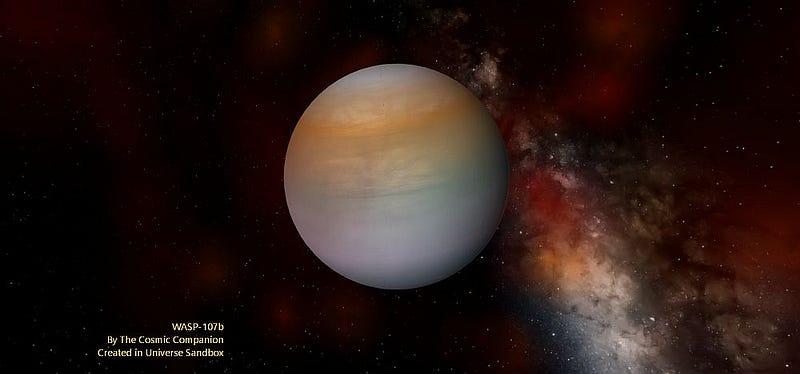Exploring the Unique Super-Puff Exoplanet WASP-107b
Written on
Chapter 1: Introduction to WASP-107b
The exoplanet known as WASP-107b, often referred to as a "super-puff," possesses an extraordinarily low density that challenges previous astronomical assumptions.

Despite its size being comparable to Jupiter, WASP-107b has only about one-tenth of Jupiter's mass. This unique characteristic makes its density remarkably lower than what scientists believed was feasible. The discovery of this peculiar exoplanet opens new avenues for research in planetary science.
The research team, led by Caroline Piaulet, a Ph.D. student from the Université de Montréal’s Institute for Research on Exoplanets (iREx), believes that additional super-puff planets may exist in various solar systems, further expanding our understanding of planetary formation.
Section 1.1: The Formation of Super-Puff Planets
Planets typically form in protoplanetary disks filled with gas and dust surrounding young stars. Historically, our knowledge of gas giant formation was primarily derived from Jupiter and Saturn, leaving many questions about how such unique planets like WASP-107b could form.
Calculations indicated that a planetary core would need a mass at least ten times that of Earth to accumulate sufficient gas for gas giant formation, which is far more than what WASP-107b possesses. So, what led to the formation of this cotton candy-like planet?
Subsection 1.1.1: The Migration Theory
According to Eve Lee from McGill University, the most likely scenario for WASP-107b's formation is that it initially formed far from its star, where the cooler gas in the protoplanetary disk allowed for rapid gas accretion. Later on, the planet migrated closer to its star, either through interactions with the disk or other nearby planets.
Section 1.2: Challenging Previous Assumptions
Super-puff planets are the least dense category among exoplanets, yet even these were previously thought to have limits on their density. The findings regarding WASP-107b challenge these long-held beliefs.
Piaulet’s team utilized data from the Keck Observatory in Hawai’i to delve into the mass and composition of this exoplanet, which was discovered in 2017. They employed the radial velocity method to analyze the gravitational effects a star experiences due to the orbiting planet. Their findings indicated that WASP-107b has a solid core approximately four times the mass of Earth, suggesting that over 85% of its mass is attributed to its atmosphere. For comparison, Neptune retains only 10 to 15% of its mass as atmospheric content.
“We had numerous inquiries regarding WASP-107b. How could such a low-density planet form? And how has it maintained its extensive gas layer in light of its proximity to its star?” Piaulet elaborated.
Chapter 2: Atmospheric Observations and Insights
Further atmospheric studies of WASP-107b using the Hubble Space Telescope revealed unexpectedly low levels of methane, where higher concentrations were anticipated.
The WASP-107 system also houses a second exoplanet, WASP-107c, which is about one-third the mass of Jupiter and orbits the central star in an elliptical path every three years—compared to WASP-107b's rapid 5.7-day orbit.
“This research fundamentally addresses how giant planets can develop and grow. It offers substantial evidence that a significant gas envelope can be formed around cores that are considerably less massive than previously thought,” stated Björn Benneke, a professor of astrophysics at UdeM.
With the upcoming launch of the James Webb Space Telescope, astronomers anticipate gaining even deeper insights into exoplanets and their atmospheres, including those within the WASP-107 system.
James Maynard is the founder and publisher of The Cosmic Companion, residing in Tucson with his wife, Nicole, and their cat, Max. Join The Cosmic Companion Network for more engaging content, including podcasts, videos, and newsletters!